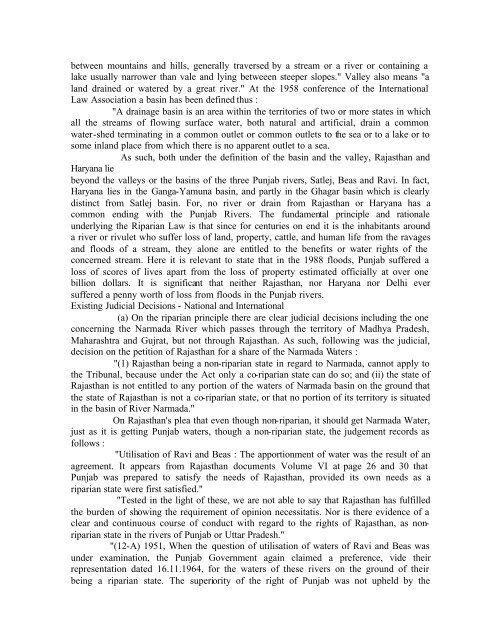Fundamentalism and the Sikh Religious Tradition by T.N. Madan
Fundamentalism and the Sikh Religious Tradition by T.N. Madan
Fundamentalism and the Sikh Religious Tradition by T.N. Madan
You also want an ePaper? Increase the reach of your titles
YUMPU automatically turns print PDFs into web optimized ePapers that Google loves.
etween mountains <strong>and</strong> hills, generally traversed <strong>by</strong> a stream or a river or containing a<br />
lake usually narrower than vale <strong>and</strong> lying betweeen steeper slopes." Valley also means "a<br />
l<strong>and</strong> drained or watered <strong>by</strong> a great river." At <strong>the</strong> 1958 conference of <strong>the</strong> International<br />
Law Association a basin has been defined thus :<br />
"A drainage basin is an area within <strong>the</strong> territories of two or more states in which<br />
all <strong>the</strong> streams of flowing surface water, both natural <strong>and</strong> artificial, drain a common<br />
water-shed terminating in a common outlet or common outlets to <strong>the</strong> sea or to a lake or to<br />
some inl<strong>and</strong> place from which <strong>the</strong>re is no apparent outlet to a sea.<br />
As such, both under <strong>the</strong> definition of <strong>the</strong> basin <strong>and</strong> <strong>the</strong> valley, Rajasthan <strong>and</strong><br />
Haryana lie<br />
beyond <strong>the</strong> valleys or <strong>the</strong> basins of <strong>the</strong> three Punjab rivers, Satlej, Beas <strong>and</strong> Ravi. In fact,<br />
Haryana lies in <strong>the</strong> Ganga-Yamuna basin, <strong>and</strong> partly in <strong>the</strong> Ghagar basin which is clearly<br />
distinct from Satlej basin. For, no river or drain from Rajasthan or Haryana has a<br />
common ending with <strong>the</strong> Punjab Rivers. The fundamental principle <strong>and</strong> rationale<br />
underlying <strong>the</strong> Riparian Law is that since for centuries on end it is <strong>the</strong> inhabitants around<br />
a river or rivulet who suffer loss of l<strong>and</strong>, property, cattle, <strong>and</strong> human life from <strong>the</strong> ravages<br />
<strong>and</strong> floods of a stream, <strong>the</strong>y alone are entitled to <strong>the</strong> benefits or water rights of <strong>the</strong><br />
concerned stream. Here it is relevant to state that in <strong>the</strong> 1988 floods, Punjab suffered a<br />
loss of scores of lives apart from <strong>the</strong> loss of property estimated officially at over one<br />
billion dollars. It is significant that nei<strong>the</strong>r Rajasthan, nor Haryana nor Delhi ever<br />
suffered a penny worth of loss from floods in <strong>the</strong> Punjab rivers.<br />
Existing Judicial Decisions - National <strong>and</strong> International<br />
(a) On <strong>the</strong> riparian principle <strong>the</strong>re are clear judicial decisions including <strong>the</strong> one<br />
concerning <strong>the</strong> Narmada River which passes through <strong>the</strong> territory of Madhya Pradesh,<br />
Maharashtra <strong>and</strong> Gujrat, but not through Rajasthan. As such, following was <strong>the</strong> judicial,<br />
decision on <strong>the</strong> petition of Rajasthan for a share of <strong>the</strong> Narmada Waters :<br />
"(1) Rajasthan being a non-riparian state in regard to Narmada, cannot apply to<br />
<strong>the</strong> Tribunal, because under <strong>the</strong> Act only a co-riparian state can do so; <strong>and</strong> (ii) <strong>the</strong> state of<br />
Rajasthan is not entitled to any portion of <strong>the</strong> waters of Narmada basin on <strong>the</strong> ground that<br />
<strong>the</strong> state of Rajasthan is not a co-riparian state, or that no portion of its territory is situated<br />
in <strong>the</strong> basin of River Narmada."<br />
On Rajasthan's plea that even though non-riparian, it should get Narmada Water,<br />
just as it is getting Punjab waters, though a non-riparian state, <strong>the</strong> judgement records as<br />
follows :<br />
"Utilisation of Ravi <strong>and</strong> Beas : The apportionment of water was <strong>the</strong> result of an<br />
agreement. It appears from Rajasthan documents Volume VI at page 26 <strong>and</strong> 30 that<br />
Punjab was prepared to satisfy <strong>the</strong> needs of Rajasthan, provided its own needs as a<br />
riparian state were first satisfied."<br />
"Tested in <strong>the</strong> light of <strong>the</strong>se, we are not able to say that Rajasthan has fulfilled<br />
<strong>the</strong> burden of showing <strong>the</strong> requirement of opinion necessitatis. Nor is <strong>the</strong>re evidence of a<br />
clear <strong>and</strong> continuous course of conduct with regard to <strong>the</strong> rights of Rajasthan, as nonriparian<br />
state in <strong>the</strong> rivers of Punjab or Uttar Pradesh."<br />
"(12-A) 1951, When <strong>the</strong> question of utilisation of waters of Ravi <strong>and</strong> Beas was<br />
under examination, <strong>the</strong> Punjab Government again claimed a preference, vide <strong>the</strong>ir<br />
representation dated 16.11.1964, for <strong>the</strong> waters of <strong>the</strong>se rivers on <strong>the</strong> ground of <strong>the</strong>ir<br />
being a riparian state. The superiority of <strong>the</strong> right of Punjab was not upheld <strong>by</strong> <strong>the</strong>
















